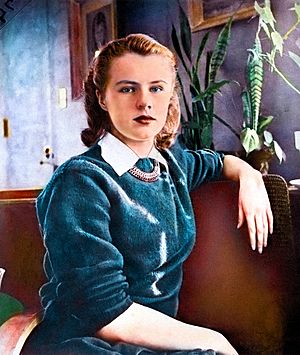Bennington Triangle facts for kids
The Bennington Triangle is a name given to an area in southwestern Vermont. An American author named Joseph A. Citro created this phrase. He used it to describe a place where several people disappeared between 1945 and 1950. Citro wrote about these strange disappearances in his books, like Shadow Child. He also mentioned that this area has similar mysterious stories to the Bridgewater Triangle in Southeastern Massachusetts.
Contents
What is the Bennington Triangle?
The exact area of this "mystery triangle" isn't perfectly clear. However, it is thought to be around Glastenbury Mountain. It includes parts of nearby towns like Bennington, Woodford, Shaftsbury, and Somerset.
Where is the Bennington Triangle?
Long ago, Glastenbury and Somerset were busy towns. People worked in logging and factories there. But by the late 1800s, these towns started to shrink. Now, they are mostly ghost towns, meaning very few or no people live there. The state of Vermont officially made them unincorporated in 1937.
According to Joseph Citro's books, people have told stories about strange events in Glastonbury for many years. The most famous story is probably about the disappearance of Paula Jean Welden.
People Who Went Missing
Between 1945 and 1950, five people disappeared in the Bennington area. No clear reasons were ever found for these disappearances.
Middie Rivers (1945)
The first person to disappear was 74-year-old Middie Rivers. This happened on November 12, 1945. Rivers was hunting near Long Trail Road and Vermont Route 9. He was guiding a group of four hunters. On the way back, he walked ahead of the group. He was never seen again.
Many people searched for him. They only found one rifle cartridge in a stream. People thought it might have fallen from his pocket. Rivers knew the outdoors very well and was familiar with the area.
Paula Welden (1946)
Paula Jean Welden, who was 18, disappeared on December 1, 1946. She was a student at Bennington College. Paula went for a hike on the Long Trail. Many people saw her leave. An employee of the Bennington Banner even gave her directions.
She was not wearing a warm jacket, even though the temperature dropped very low later. An older couple said they saw her on the trail. They were about 100 yards behind her. They said she turned a corner, and when they reached that same corner, she was gone. A huge search took place. The FBI helped, and a $5,000 reward was offered. But no trace of Paula was ever found.
Paula Welden's disappearance inspired the 1951 book Hangsaman by Shirley Jackson.
Betty Fraser (1948)
Betty Fraser, 26, disappeared on May 5, 1948. She was last seen walking unsteadily along Highway 30. A neighbor offered her a ride, but she seemed to ignore them. Her body was found a month later. It was on a forest trail seventeen miles away in West Dover. The police closed the case, but some local people still found it puzzling.
James Tedford (1949)
James E. Tedford, a veteran, went missing on December 1, 1949. This was exactly three years after Paula Welden disappeared. Tedford lived at the Bennington Soldiers' Home. He had been visiting family in St. Albans. He was seen getting on a bus there.
Witnesses said Tedford was still on the bus at the last stop before Bennington. But somewhere between that stop and Bennington, he vanished. His belongings were still on the bus. An open bus timetable was on his empty seat.
Paul Jepson (1950)
On October 12, 1950, 8-year-old Paul Jepson disappeared. He was with his mother in a truck. His mother left him alone for about an hour. When she came back, Paul was gone. Search parties looked for the child. Nothing was ever found, even though Paul was wearing a bright red jacket. This jacket should have made him easy to see.
Some stories say that search dogs tracked Paul to a local highway. This was the same highway where Paula Welden had supposedly disappeared four years earlier.
Frieda Langer (1950)
On October 28, 1950, Frieda Langer, 53, went hiking with her cousin. They were near the Somerset Reservoir. During their walk, Langer slipped and fell into a stream. She told her cousin she would go back to their campsite to change clothes. She said she would then catch up to him.
When she did not return, her cousin went back to the campsite. He found that Langer had not come back. No one had seen her since they left. For the next two weeks, many searches were done. Aircraft, helicopters, and up to 300 searchers were involved. But no sign of Langer was found.
On May 12, 1951, Langer's body was found. It was three and a half miles from the campsite. This area had only been lightly searched before. Because of the condition of her remains, the cause of her death could not be figured out.
There are no clear connections between these cases. The only links are that they happened in the same general area and during the same time period.
The Bennington Triangle in Pop Culture
The Bennington Triangle has been featured in several TV shows and podcasts.
- It was discussed in Season 3, Episode 8 of William Shatner's Weird or What? This episode was called "Mysterious Vanishings" and aired on July 23, 2012.
- The events from 1945 to 1950 were told in episode 67 of the podcast Lore. This episode was titled "The Red Coats".
- The Bennington Triangle was also shown in the paranormal TV series Most Terrifying Places in America. This show aired on the Travel Channel in 2018. The episode, "Unnatural World," shared the stories of the missing people. It also talked about local legends of the "Bennington Monster." This is a Bigfoot-like creature said to live in the woods.
See also
 In Spanish: Triángulo de Bennington para niños
In Spanish: Triángulo de Bennington para niños


